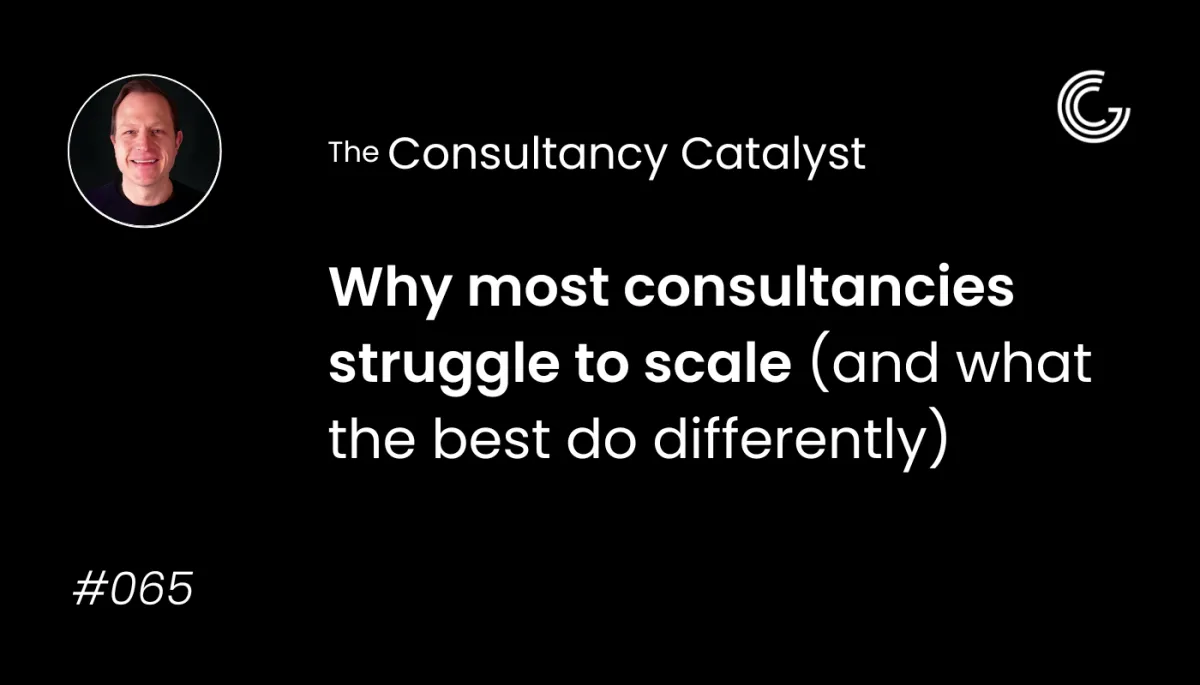The Consultancy Catalyst
Practical tips to build a more valuable, impactful and fulfilling consultancy.
Every Friday morning, you'll get 1 actionable tip to make your consultancy more valuable, impactful and fulfilling in less than 4 minutes.

Why most consultancies struggle to scale (and what the best do differently)
You aren’t short on ambition, talent, or opportunity. You’re just playing a different game - and no one handed you the playbook.
If you’ve ever thought:
“How do I clone myself?”
“Why am I either maxed out or panicking about where the next client is coming from?”
“Why are we always reinventing the wheel for every new client?”
You’re not the only consultancy owner asking those questions.
Over the last quarter, we’ve explored the hidden causes behind these challenges - and more importantly, how to solve them. This guide brings those insights together to give you a clear roadmap to sustainable, scalable growth.
The barriers consultancy leaders face when scaling
Let’s start with the truth:
Consultancies often grow quickly through referrals, reputation, and the founder’s expertise. But that growth eventually hits a ceiling.
Here’s why:
Founder dependency – You’re the rainmaker, the lead consultant, and the closer. If you step back, the whole business slows down.
Feast-and-famine cycles – You go all-in on delivery, then scramble for leads when projects end.
Custom everything – Every proposal, engagement, and process is bespoke. It creates complexity that leads to inefficiency, bottlenecks, and burnout.
Inconsistent sales systems – If you don’t have a repeatable way to attract, qualify, and convert leads, growth will always be erratic.
Volatile profits – Even with decent revenue, lack of recurring income makes planning (and sleeping) difficult.
Scaling doesn’t break a business - it exposes the parts that were never built to scale in the first place. It’s not fixing those parts that breaks businesses.
The frameworks that help consultancies scale (without breaking the business or themselves)
Scaling a consultancy isn’t about doing more—it’s about building smarter. These five building blocks form a repeatable, scalable growth system that helps consultancy leaders move beyond referrals, reduce founder dependency, and build recurring profit.
Here’s how they come together:
1. A laser-focused target audience
Scaling starts with serving the right people. Broad positioning makes your offers vague and your marketing weak.
✅ Why it works: When your audience is specific, you can tailor messaging, pricing, and services to their exact needs - making it easier to attract and convert leads.
Example: Finance Consultancy - Instead of “we help SMEs with finance,” position as:
“We help mid-sized UK manufacturing businesses reduce operational costs and increase margins through strategic financial transformation.”
2. Offer ecosystem & irresistible offer stacks
A scalable consultancy doesn’t just sell one-off projects. It builds a suite of offers that evolve with client needs - and adds high-perceived-value elements to increase conversion and justify premium pricing.
✅ Why it works: Clients get more value at each stage, and you increase revenue per client without increasing delivery costs.
Example: Finance Consultancy
A £5k Financial Health Assessment becomes an £11k perceived value offer by stacking:
Lending review
Tax optimisation insights
DIY finance course
Automated dashboards linked to Xero/QuickBooks
Clients progress naturally to higher-tier services like cash flow optimisation and ongoing CFO advisory.
3. A compelling message
If your message is vague, generic, or full of consultancy jargon, your ideal clients won’t pay attention - let alone buy.
✅ Why it works: Clear, outcome-oriented messaging grabs the right prospects and sets you apart.
Example: HR Consultancy
Instead of “we provide HR advisory services,” say:
“We help high-growth tech companies reduce employee churn and scale their teams without hiring headaches.”
It’s specific, outcome-driven, and speaks to the pain point in the client’s own language.
4. Systemised marketing & sales
If you’re still manually writing every proposal, chasing cold leads, and hoping LinkedIn posts convert - growth will stay erratic.
✅ Why it works: With marketing and sales systems in place, you attract qualified leads, shorten your sales cycle, and reduce founder dependency.
Example:
Automate your lead generation funnel, qualify leads through a pre-call questionnaire, and sell standardised offers with fixed pricing.
This alone can cut time spent on sales in half - and dramatically increase consistency in revenue.
5. Highly profitable recurring services
Projects end, but recurring services don’t - as long as you’re delighting your clients. If you want predictable revenue and long-term growth, you need to move beyond one-off engagements.
✅ Why it works: Recurring models (retainers, memberships, subscriptions) create a financial foundation that supports team growth, reinvestment, and personal freedom.
Example: Sales Consultancy
Offer a recurring service like:
Monthly sales strategy advisory (£4k/month)
Sales playbook development + quarterly refresh (£1.5k/month)
Scalable group sales coaching for client teams (£1k/month per business)
These recurring models turn sales support into an ongoing partnership - with minimal additional delivery cost.
Real-world example: Scaling a finance consultancy
Let’s bring this to life.
A finance consultancy was doing well - solid referrals, strong delivery, consistent demand. But growth had stalled. Each month started at zero, the founder was involved in every deal, and scaling felt like pushing a boulder uphill.
What changed:
Refined their target audience – Narrowed focus to mid-sized UK manufacturers.
Built an offer ecosystem – Introduced a 3-tier pricing model with stacked value.
Clarified their message – Replaced vague positioning with outcome-based messaging.
Systemised marketing and sales – Launched an automated funnel and templated proposals.
Introduced recurring revenue – Built in CFO advisory, dashboard reporting, and a membership.
The result
In 6 months, they stabilised revenue, doubled client lifetime value, and halved the founder’s time spent on sales - freeing them up to lead the business.
Wrapping up: A roadmap to scalable growth
Scaling isn’t about pushing harder - it’s about building smarter.
You need:
A clear, structured offer.
A compelling message that attracts the right clients.
A marketing and sales system that works while you deliver.
Delivery that doesn’t depend on the founder.
Recurring profit that fuels consistent growth.
This is how consultancies move beyond survival and start to scale sustainably.
Start your journey with the Ready-To-Buy Playbook
If you’re ready to build a consultancy that scales without burning out, the Ready-To-Buy Playbook will walk you through the frameworks you need to:
✅ Structure your pricing
✅ Refine your offer
✅ Build consistent lead flow
✅ Create recurring profit
👉 Download the Ready-To-Buy Playbook now and start building a business that works for you - not the other way around.
Subscribe to the Newsletter
Join fellow specialist consultancy owners reading The Consultancy Catalyst every Friday for exclusive tips, strategies and resources to make your consultancy move valuable, impactful and fulfilling.
Testimonials

We are so grateful for the amazing photos that [photographer's name] took of our wedding day.
Jane Doe



